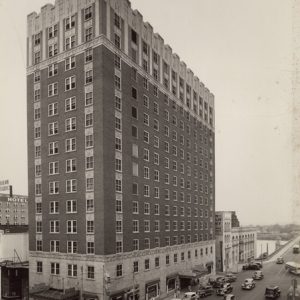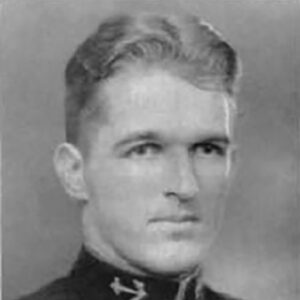calsfoundation@cals.org
Frank Glasgow Tinker (1909–1939)
Frank Glasgow Tinker was a distinguished American mercenary pilot for forces of the Spanish Republic during the Spanish Civil War (1936–1939). A graduate of DeWitt High School and the Naval Academy, Tinker was the top American ace for the Republican Air Force during the Spanish Civil War.
Frank Tinker was born on July 14, 1909, in Kaplan, Louisiana, the son of Frank Glasgow and Effie Tinker. He had two sisters. The family moved to DeWitt (Arkansas County) on July 3, 1924. Tinker graduated from high school in DeWitt in 1926 and, at the age of seventeen, joined the U.S. Navy. Tinker spent three years in the navy before receiving a prestigious appointment to the Naval Academy at Annapolis. After graduating from Annapolis in 1933, Tinker was sent to Randolph Field, Texas, for flight training. In six months, he graduated and was transferred to Pensacola, Florida, where he completed his training.
During 1934–1935, Tinker was stationed with the West Coast Fleet. He served as an observer for the navy and crashed with his pilot on May 15, 1935. Tinker’s only grievance seems to be his prematurely gray hair, which he attributed to this crash. Tinker lasted only six months in the fleet. After a quarrel in Long Beach resulted in a court-martial, Tinker again got into a clash only a couple of months later and had his commission revoked. Later in 1935, Tinker joined the crew of a Standard Oil tanker running from New York to Baton Rouge, Louisiana, as a third mate. By July 1936, Tinker left his job with Standard Oil.
Tinker was never married and had no children.
By December 16, 1936, Tinker left for Spain to fight with the Republican forces against the Nationalists, led by Francisco Franco, and the fascist nations of Italy and Germany. Earlier, Tinker attempted to join the Ethiopian government as a pilot for Addis Ababa against Benito Mussolini and his invading Italian forces. This failed, as the Ethiopian government had no air force of its own. Tinker believed that Adolf Hitler and Mussolini were involved in what amounted to a military invasion of Republican Spain, and he decided to offer his services as a fighter pilot for the Republican Air Force.
When Tinker joined the Republican Air Force, it was contrary to the United States’ policy of non-intervention. To circumvent this policy, the Spanish ambassador to Mexico recruited Tinker in secret. This was in response to letters sent by Tinker to the Spanish ambassador in Washington DC and Mexico City, and the Spanish Consul-General in New York City. As Tinker began his clandestine voyage to Spain, he took the alias Francisco Gomez Trejo. During the war, Tinker became a squadron commander and was credited with eight enemy kills, making him an ace. By late August 1937, Tinker returned to the United States.
During the Spanish Civil War, Tinker flew with other notable American mercenaries, including Harold Dahl, Orrin Dwight Bell, Derek Dickinson, Jim Allison, Charlie Koch, and Albert Baumler. Tinker has been placed in the American Fighter Aces Association for his eight confirmed kills and recorded compensation totaling $18,500 from his exploits in the Spanish Civil War. His eight confirmed enemy kills of the war placed him at the top among the American pilots.
After the war, Tinker was a guest speaker in New York on the radio program “We the People,” discussing his feats in civil war Spain. Tinker also wrote a series of articles for the Saturday Evening Post titled “Some Still Live.” The articles were published in book form with the same name in 1938. He wrote a number of other articles including a series for the Arkansas Gazette Magazine describing his voyage from St. Charles (Arkansas County) down the White and Mississippi rivers to New Orleans with his fox terrier.
Tinker’s death is reported as a suicide; however this has continued to be controversial. He was found in the Hotel Ben McGehee in Little Rock (Pulaski County) on June 13, 1939, with a .22 caliber weapon lying on a chair three feet from the bed. A bottle of scotch, relics of Tinker’s career with La Patrulla Americana during the Spanish Civil War, and an acceptance letter from the Chinese Air Force were scattered across the room. The letter was the result of correspondence between Tinker and General Claire Chennault. His suicide has been attributed to shellshock from the war and even maltreatment from the U.S. government. Neither has been substantiated, and some even consider his apparent suicide as nonsense, since Tinker was known to carry a .45 Colt with him in his suitcase. Ernest Hemingway, an admirer of Tinker, after learning of Tinker’s suicide, reportedly commented he would have tried to dissuade Tinker from taking his own life if he had known of Tinker’s plight.
Tinker was buried in DeWitt with “¿Quien Sabe?” (“Who knows?”) engraved on his tombstone.
For additional information:
Edwards, John Carver. Airmen without Portfolio: U.S. Mercenaries in Civil War Spain. North Charleston, SC: Global Book Publisher, 2003.
“Frank G. Tinker, Noted Aviator, Ends Life Here.” Arkansas Gazette. June 14, 1939, pp. 1, 20.
Tinker, Frank G. Some Still Live. New York, NY: Funk & Wagnalls Company, 1938.
Clark Donat
Fayetteville, Arkansas
 Hotel Ben McGehee
Hotel Ben McGehee  Frank Tinker's Fighter Plane
Frank Tinker's Fighter Plane  Frank G. Tinker
Frank G. Tinker 




Comments
No comments on this entry yet.